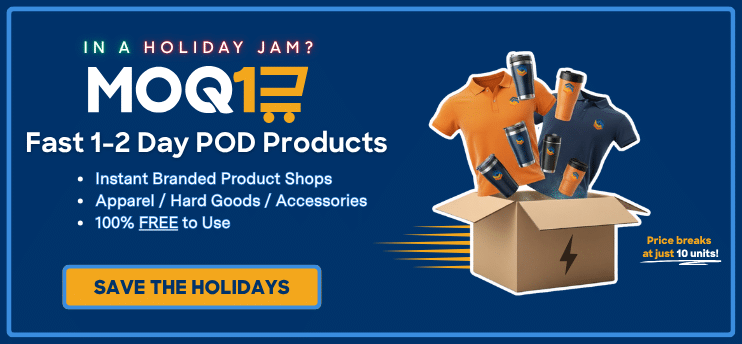Show Your Logo, PPAI 100’s No. 94 distributor, has spent five years and hundreds of thousands of dollars trying to transition to a new enterprise resource planning system.
Every time the Oswego, Illinois-based company comes close, an issue arises, and the process is abandoned.
Coming out of the pandemic, the firm had a contract ready with an industry-specific ERP provider only for the latter to refer Show Your Logo to a non-promo-specific ERP provider. Uncomfortable with the last-minute switch, the firm backed away and signed up with a different company. After 70% of the system was built, Show Your Logo leaders realized there were flaws.
“They spent 30 minutes doing a demo, and we said no, that doesn’t work,” recalls Steve Brungart, general manager at Show Your Logo. “They asked what we wanted it to do, and we spent the next two hours explaining it. After the call, I told our owner how amazing it was that they took all these notes and could make this happen.
“A half hour later, the head guy from the ERP provider called and said all the things we asked for are going to break the system. So, we backed out of that, too.”

Steve Brungart
General Manager, Show Your Logo
Third time wasn’t a charm, either, as a breakdown in communication between both parties resulted in Show Your Logo leaving a glitch-filled system that half of its sales reps had been using for six months. Brungart later learned that the ERP provider fired its chief technology officer at about the same time his firm was having issues.
“I wish I would’ve known because I would’ve been more patient,” he says.
While Brungart continues to shop around, Show Your Logo has been relying upon the same system for the past 13 years. Although it does everything “reasonably well,” Brungart says it hasn’t been updated since the firm has been on it, and it doesn’t tie into any other application.
“With our current ERP, I can’t get a database with my customer’s name, contact name and email address,” he says. “I’m fearful because, especially with software, if you don’t innovate, you die. I don’t know any big players on it, so if there isn’t one on it, who’s going to keep this thing going?
“But I’m scared to pick up the project again because I’ve been burned so many times.”
Growing Trend
Promotional products companies use ERPs to streamline operations and integrate core business functions. These systems centralize data for inventory, order processing, customer relationship management and accounting. With the complexity of custom product orders and tight deadlines, ERP systems enable promo firms to scale, enhance customer service and stay competitive.
- Aside from AI applications, ERP implementations and upgrades were the most cited IT-related developments among 2025 PPAI 100 companies.
Previous systems, many of which had been in place for decades, had become outdated. As promo firms’ needs evolved and the pace of technology – spurred by the rise of AI – accelerated, business leaders realized they had to make a change to remain competitive in the marketplace.
RELATED: Find ERP Specialists In The PPAI Solutions Center
PromoShop, PPAI 100’s No. 20 distributor, spent the first half of 2024 migrating to an ERP system, which included a fully integrated buildout for absorbing invoices and information through universal data feeds into its on-premises QuickBooks environment.
- The Los Angeles-based company spent Q3 2024 focused on integrating finance processes and optimizing workflows for automation while taking a deeper dive into e-commerce platforms and their integration in Q4.
PromoShop, which has earned PPAI 100 High Marks in Innovation over the past two years, also expanded its partnerships and programming to facilitate one-click purchasing through SSI suppliers, implementing low/no-touch features for quick and seamless ordering.

Kate Alavez, MAS
President, PromoShop
“We opted for a layered tech stack instead of a single ERP solution model to match solutions to specific problems,” says Kate Alavez, MAS, president of PromoShop and a member of the PPAI Board of Directors. “Our strategy is based on the belief that the industry will continue to evolve in the data space, necessitating a multi-tiered solution with foundational data exchanges that benefit the entire supply chain.”
Illini/Altco, PPAI 100’s No. 51 supplier, wanted to move toward greater digital connectivity, including the ability to eventually support PromoStandards integration, which is something that requires a modern ERP as its foundation.
“Our proprietary system lacked the flexibility and remote accessibility we needed to support our growing operations,” says Sabrina Wilt, director of product development and marketing at Illini. “Overall, we needed a platform that could evolve with us and meet today’s business expectations.”
Illini, like several of its PPAI 100 counterparts, chose business services member NetSuite, one of the most popular ERP systems in the world. Since implementation, Wilt says the firm has seen improved reporting, more accurate data and much better visibility across departments. “The system’s ability to adapt to evolving workflows has created real value for our team and our customers,” Wilt says.
Sabrina Wilt
Director of Product Development & Marketing, Illini
- In 2022, PPAI launched a program that gave members discounted access to the business management system. As part of the agreement, PPAI members receive preferred pricing on new subscription services and are offered networking opportunities with fellow NetSuite users.
ePromos Promotional Products, PPAI 100’s No. 27 distributor, which consistently receives high marks in Innovation, also chose NetSuite because it met many critical requirements, including industry tool integrations and built-in sales functionalities.
“We sought a platform that would boost our sales team’s productivity by simplifying the ordering process, allowing them to focus more on selling rather than navigating a complex, multi-step order entry system,” say ePromos co-owners Marc Puglisi, CEO, and Christine Puglisi, chief marketing officer.
RELATED: Smarter Systems, Stronger Business: How BPC Helped Foxtrot Marketing Optimize With NetSuite
Since implementation, ePromos has realized significant improvements in both sales and operations, particularly in managing orders and quotes, and its data storage capabilities have been enhanced, according to the duo. Moreover, the ability to integrate with previously incompatible tools has dramatically improved cross-departmental processes, resulting in greater overall efficiency.
“The platform’s flexibility allowed us to customize the out-of-the-box solution to align closely with our organizational style and operational needs, making it an excellent fit for our business,” the duo says.

Jonas Temple
CIO, The Magnet Group
Meanwhile, The Magnet Group’s previous ERP system was a combination of two purchase packages and a home-grown application. Although they served PPAI 100’s No. 9 supplier well for many years, the architecture of those systems didn’t translate well into an e-commerce business environment, according to CIO Jonas Temple.
- As a result, the Alpharetta, Georgia-based firm, which earned high marks in Innovation this year, selected Odoo as its new ERP.
“We’ve streamlined the technology stack required to support our business and folded numerous ‘silo’ applications into Odoo,” Temple says. “Because of its capabilities, we’ve eliminated paper job packets that would be carried from one department to another.
“We’ve rolled out a new website generated by our Odoo environment and now host our ERP in the cloud so a power loss at our main data center doesn’t take the entire company down. We’ve also automated product data feeds to PromoStandards and SAGE.
“I could go on and on…”
‘Real Learning Curve’
Of course, as Brungart attests, ERP transformations can be challenging.
Typical headaches include high upfront costs, complex customization needs and time-consuming data migration. Plus, organizations often face employee resistance due to changes in workflows, which can require extensive training.
“If your business is complex, and ours definitely is, then understand this: Nothing in your organization will be untouched,” says Todd Pottebaum, MAS+, president of Quality Resource Group, PPAI 100’s No. 53 distributor, and the 2026 recipient of the PPAI Distinguished Service Award.

Todd Pottebaum, MAS+
President, Quality Resource Group
The Minneapolis-based company, which achieved high marks in Innovation in 2024 and 2023, has also implemented NetSuite. But it has been a “real learning curve” for staff, Pottebaum admits.
“One of the biggest lessons for us has been the importance of change management,” he says. “I once heard a phrase that stuck with me: ‘Everyone wants change, but no one wants to be changed.’ That sums up ERP transformation pretty well.
“You’re not just learning a new system. You’re learning a new language. Some people adapt quickly, while others need more support and reinforcement. And you have to plan for both. That said, we’re starting to see the payoff: better accuracy, faster turnaround, less reliance on tribal knowledge and more streamlined workflows that create a better experience for both our clients and our employees.”

Jamie Gamez
VP, Morris Magnets
Fortunately for Morris Magnets, PPAI 100’s No. 70 supplier, its NetSuite implementation was “smoother than anticipated.” Jamie Gamez, vice president of the Monroe, Washington-based company, says the process began in October and went live six months later.
- Morris Magnets is currently in the second phase of completing its remaining PromoStandards endpoints, which include product data, pricing and media.
In addition to an elevated customer experience with real-time updates on orders and a more accurate view of inventory, Gamez expects NetSuite will improve administrative tasks by reducing unnecessary redundancy and provide access to live data analytics of operations.
“The tools for our sales team are highly anticipated as well,” Gamez says. “With customer expectations evolving around delivery times and communication touchpoints during the life of an order, we want the ability to continue delivering the five-star service we’re known for.”
Nathan Garden
President, Versa-Tags
Versa-Tags, PPAI 100’s No. 65 supplier, is only a few months into using Durst Lift ERP, which will provide a payment portal as well as overall customer portal for uploading artwork and approving proofs.
The biggest issue with the Missouri-based company’s previous ERP was that it wasn’t print specific. “We’re a graphics printer and we were using a general ERP, which didn’t allow us to create workflows that were intuitive to the normal processes for any graphics printer,” says Nathan Garden, president of Versa-Tags.
“You must find an ERP that works for you – not the other way around. It should automate workflows and make information for customers more transparent and easier to find.”
Jeremy Bayness, chief technology officer at BAG MAKERS, PPAI 100’s No. 24 supplier, agrees.

Jeremy Bayness
CTO, BAG MAKERS
“Don’t get locked into overly rigid systems that don’t allow you to customize the software to meet your own company goals,” Bayness says. “Do your due diligence to find the right fit for your exact needs.”
BAG MAKERS is upgrading to a new version of SAP ERP with automatic data archiving that will not only prevent future data creep but also enhance the user experience. Bayness expects employees will be using the new system at the dawn of 2026.
“Make sure to have buy-in from your employees on why the switch is occurring by offering them insight into the process,” Bayness says. “You also want to make sure you dedicate more time than you think will be needed for user acceptance training to work out all the bugs before even considering a go-live date. While that may drive your upfront implementation costs up, it will save money in the long-term by having a fully functional system when your team flips the switch.”
Tips For Choosing An ERP
The universal advice for considering a new ERP or an upgrade is to do your homework. You can’t just jump into it – it’s a lengthy process that demands preparation, commitment and patience.
“Audit your real pain points first,” says Martin Olsina, executive vice president of operations at Spector & Co., PPAI 100’s No. 18 supplier, which achieved high marks in Innovation this year.
Because Spector & Co.’s legacy ERP was running on a release that was more than 10 major versions behind, Olsina says it created a bevy of pain points, such as hardware integrations, user experience, data handling, reporting, process automation, regulatory and security concerns.
Martin Olsina
EVP of Operations, Spector & Co.
After exploring a full re-platform to a new ERP, Olsina says leadership concluded that the development and change management costs outweighed the benefits, so the firm pivoted to the upgrade option – the latest Macola release with Synergy and Event Manager applications.
Olsina says the benefits are plentiful:
- lower total cost of ownership
- real-time operational visibility
- API ready architecture
- process automations
- regulatory compliance and security
- fast user migration/adoption without business disruptions
“You have to separate ‘platform change’ from ‘process change’ and negotiate long-term support up front,” Olsina says.
Echoing that sentiment is Colleen Leyanna, senior director of customer engagement at Edwards Garment, PPAI 100’s No. 19 supplier, which switched to Microsoft Dynamics 365.

Colleen Leyanna
Sr. Director of Customer Engagement, Edwards Garment
“Remember you are making the change for a reason,” Leyanna says. “Be open to and seriously consider business process changes. Let your new system work for you and challenge every ‘we’ve always done it this way’ answer – this will help reduce customizations.”
Leyanna encourages firms to have a dedicated team – comprised of both internal staff and vendor partners – that has the bandwidth to make the project successful. After all, identifying what to build, testing and fixing bugs is time-consuming.
“Don’t drink from a fire hose,” Leyanna adds. “Have a gradual approach to processing in the new system on Day 1 and forward. Make sure there’s a detailed cutover plan and call out every action. Each department needs to highlight the dependencies.”

Phil Gergen
CIO, Koozie Group
Phil Gergen, chief information officer at Koozie Group, PPAI 100’s No. 11 supplier, emphasizes the importance of focusing on the data. “It seems obvious, but taking the time to make sure your data is right will make the project go much smoother,” Gergen says.
Koozie Group, which has achieved high marks in Innovation over the past two years, brought all its orders into a single ERP system (Oracle eBusiness Suite), ensuring consistency across its entire product portfolio.
“Make sure you don’t lose what makes you unique when moving ERPs,” Gergen adds. “Lots of ERP implementations are designed to have you follow the ERP process, but if you lose what your customers like about you, it can have unintended consequences that overshadow the benefits of updating your ERP.”
‘So Many Options’
As his search continues, Brungart says he’s seen demos from at least nine ERP providers over the past three months. He hopes to find one that can do the basics (“order entry, order follow up, CRM, a little accounting”) well and has the option of connecting with other software through APIs.
“The big software packages aren’t for us because they’re just too clumsy,” he says. “Yes, they can do everything, but it takes too many clicks, or it’s done in a weird way.”
Inspired by his peers, Brungart says PromoShop’s layered tech stack appeals to him. “It really goes against what most everyone else is doing, but it seems the most flexible approach,” he says. “Business practices and customer needs are evolving quickly in recent years. Being adaptable while maintaining a cohesive tech environment makes a lot of sense to me.”
Ultimately, Brungart hasn’t come any closer to finding the perfect fit for Show Your Logo, but that hasn’t deterred him. He understands the importance of an ERP in today’s competitive landscape.
“Every distributor and supplier have slightly different needs and goals,” Brungart says. “Add in the complexity of ordering and making customized products for end users, and it’s no wonder there isn’t a one-size-fits-all software for the industry.”


